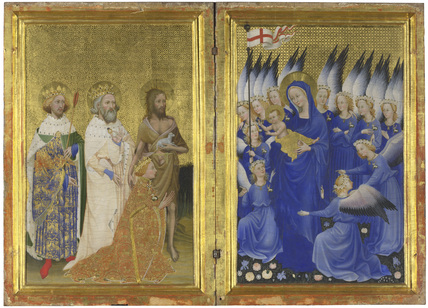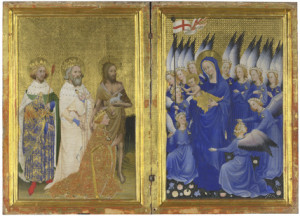
PREVIOUS: MARGARITO D’AREZZO – THE VIRGIN AND CHILD
The Wilton Diptych: about 1395-1399
The previous picture was one of the earliest signed works in the National Gallery, in contrast the artist here is unknown – although we can see that they were someone of immense talent and craftsmanship. Look at the fine patterns in the gold background on the left hand side for example, or the exquisite detail in the angels’ wings and crowns of flowers. It’s painted on wooden panels using egg tempera – a type of paint that dries really quickly which makes it difficult to get gradations of colour, so the blues of the angels’ robes again show the artist’s skill.
A diptych is a painting in two parts, hinged so that it closes like a book. We’re looking at the inside of the ‘book’ here and can see that even after 600 years these images are wonderfully preserved and alive.
It’s called the Wilton Diptych because it resided in Wilton House, the home of the Earls of Pembroke, who owned the work until the National Gallery bought it in 1929.
It was made for the person we see kneeling in the left hand panel – Richard II. It was a portable altarpiece that he would take with him for private prayer as he travelled. Look at the amount of gold on the work, and the amount of blue. This is a pigment called ultramarine, which was incredibly rare and incredibly expensive, so this is would always have been an object of great physical value.
The blues are used extensively in the right hand panel, which represents Heaven. We see Christ in the arms of the Virgin Mary, surrounded by angels and in a field of flowers. The left hand panel is the Earthly realm, Richard is kneeling and being presented to Christ by two previous English kings – Edmund and Edward the Confessor, who were both saints – and by St John the Baptist. We can tell who’s who from what they’re holding – St Edmund the arrow as a symbol of his martyrdom, St Edward with a ring, an allusion to a miracle attributed to him, and St John holding a lamb and wearing his camel hair rags. Richard’s birthday was 6 January – Epiphany, the day the three kings visited the infant christ.
Richard is wearing his personal emblem – a white hart – which is also woven into his robes, and in ‘Heaven’ the angels are also wearing the insignia. And can you see the orb at the top of the flagpole? Recent restoration has revealed a tiny picture within this: the image of a green island, surrounded by a sea that was painted silver. Think of Shakespeare’s words in his play Richard II – “This little world, this precious stone set in a silver sea”. And look at Richard’s hands – is he praying, or are they open to receive the kingdom – symbolised by the banner and the flagpole – which Christ and the Virgin are presenting to him?
Richard had a turbulent reign and when this picture was painted his position was under threat (in fact he was deposed in 1399). So one interpretation is that this painting was a reassurance to Richard that he had a divine right to rule and that heaven and the angels were on his side.
If you’d like to go face to face with this picture and have me tell you all about it, you can find out details and dates of my National Gallery guided tours here.

